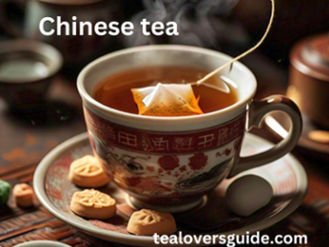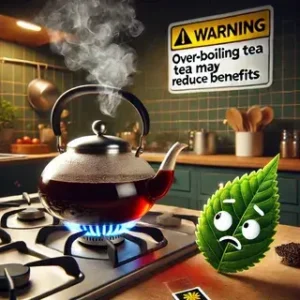Chinese tea is one of the most popular drinks in the world because it has so many flavor options and is good for you. Different kinds of Chinese tea, from mild white tea to strong black tea, naturally have their traits and ways of being made that give them their taste and smell.
No matter how much you love Chinese tea or how little you know about it, learning about the different kinds of tea is a great way to pass the time. There will be new tastes and smells, as well as a lot of history and culture that beer has made over the years.
In this article, we will be able to explore the wonderful world of Chinese tea: the differences among various types of Chinese tea, their peculiar characteristics, and how they are produced.
The Origin of Chinese Tea
Chinese tea has been around for over 4,000 years; its origins, however, date back to the legendary Emperor Shen Nong, who is said to have discovered tea when leaves from a wild tree blew into his pot of boiling water. That chance occurrence gave rise to Chinese tea and marked the start of one of the world’s most famous libations.
For centuries, Chinese tea developed into an art form with its rituals, aesthetics, and varieties. It perfected the craft of growing, harvesting, and processing tea leaves into various forms of Chinese tea that are prized and adored throughout the world.
The Importance of Chinese Tea in Culture
The Chinese tea has evolved from just being an ordinary drink. It has become a cultural necessity and is extensively used to symbolize respect, purity, and humility at numerous ceremonies, including weddings. The art of brewing and drinking of this refreshing beverage is regarded as meditation, as if connecting with nature and appreciating the simple things of life.
Chinese tea is also used for medicinal purpose in traditional medicine. It possesses medicinal values that ensure balance in the body’s nature, thereby being linked with a better healthier life and longer existence. Every kind of Chinese tea is claimed to possess some benefits towards an enhanced healthier life with respect to food digestion, stress reduction, and keeping one’s mind in focus.
Types of Chinese Tea: An Overview
Chinese tea, divided into its various kinds, that vary in flavor, aroma, and preparation methods. Such kinds may be categorized into a total of six: green tea, white tea, black tea, oolong tea, yellow tea, and dark tea, known as Pu-erh tea. In fact, each of these kinds of tea is prepared through various processing techniques that contribute to their specific flavor characteristics and properties.
Now, let’s briefly go through the **varieties of Chinese tea**:
1. Green Tea (Lǜ Chá)
Green tea, one of the most famous varieties of Chinese tea, is made from unoxidized leaves and therefore is the least processed, preserving many natural flavor and health-oriented constituents. It has a light, fresh-tasting flavor that might be described as grassy or vegetal.
Green tea is rich in antioxidants, which include catechins among others. This makes it have so many supposed health benefits. A healthy diet of green tea has been linked to improved brain functions, weight loss, and the risk reduction of contracting some diseases.
2. White Tea (Bái Chá)
White tea is another type of Chinese tea. It is the least processed of all tea varieties, made by using very young tea leaves and buds that are air-dried. The lighter processing of this process leaves behind in white tea a subtle flavor and pale color. White tea tastes, among other things, light, sweet, and slightly fruity.
White tea is one of the rich types of tea in antioxidants, and it has been a lot associated with several health benefits; such benefits include a better heart, reduced inflammation, and healthy skin.
3. Black Tea (Hóng Chá)
Black tea, or “hong cha” in Chinese, is completely oxidized, which gives it a dark color and a very full flavor. Black tea is probably the most commonly drunk form of Chinese tea, at least in the West. Black tea often goes into mixes such as Earl Grey and English Breakfast, among many others.
Black tea contains more caffeine than most Chinese tea types, therefore an even better option for those seeking a caffeine boost. It is also abundant in antioxidants which fight against heart conditions, and overall bring good health.
4. Oolong Tea (Wūlóng Chá)
A partially oxidized tea, oolong is somewhere in the middle of green and black tea in terms of oxidation. Its unique flavor arises from this strange processing technique – including sweet and floral as well as rich and toasty flavors to anything in between.
Oolong tea is highly known to benefit digestive powers that prevent people from gaining weight. It also makes up free radical antagonists and antioxidants for heart health.
5. Yellow Tea (Huáng Chá)
Yellow tea is a rare, very expensive **Chinese variety of tea** processed in an unusual method. The light fermentation of the tea leaves followed by slow oxidation gives yellow tea a bland taste, close to green tea but richer and smoother and with a golden color.
Yellow tea is less common compared to other **kinds of Chinese teas** but is valued for its smooth taste and high antioxidant properties, thus providing several health benefits, which may contribute to a healthy liver and ease the condition to get one to relax.
6. Dark Tea – Pu-erh (Hēi Chá)
Dark tea is another terminology for Pu-erh tea. Chinese fermented tea, this particular tea type has a unique way of aging. The compressed leaves are left to age as teas cakes or bricks and sometimes, this aging takes centuries. At times, it remains in this state for decades. Fermentation gives dark tea an earthy rich flavor.
Pu-erh tea is known to contain digestive benefits and is taken after meals so as to digest. It has been said to control cholesterol, thus improving metabolism.
Here are some frequently asked questions (FAQs) about Chinese tea:
1. What is Chinese tea?
Chinese tea is essentially tea that has been conventionally grown, harvested, and processed in China. It is made in various kinds of tea, which includes green tea, black tea, white tea, oolong tea, yellow tea, and Pu-erh or dark tea.
2. What are the main types of Chinese tea?
There are six major types of Chinese tea: green, black, white, oolong, yellow, and dark (Pu-erh) tea. They differ significantly in taste and smell and techniques of processing.
3. How is Chinese tea different from others?
Chinese tea is characterized by a rich history that is pegged with much cultural heritage with different flavors and styles, which most times is associated with different areas. Processing techniques are far much different in Chinese tea as compared to the rest of the worlds, hence this gives it flavor that it produces and makes healthier.
4. What are the health benefits of Chinese tea?
Chinese tea is rich in antioxidants and offers various health benefits, including benefits in heart health, digestion support, metabolism boost, stress relief, and even induced relaxation. Different types of Chinese tea could offer different health benefits, like losing weight or detoxing.
5. How should I brew Chinese tea?
The brewing method varies with the type of Chinese tea. In general, one may use loose-leaf tea, steep in hot water, and avoid overbrewing, which could become too bitter. A few teas, such as Pu-erh, require longer infusion times, while green and white teas are shorter.
6. What is the best type of Chinese tea for beginners?
For beginners, green tea (such as Longjing) or oolong tea (such as Tieguanyin) is often a good place to start. These types of Chinese tea have pleasant, smooth flavors and are easy to brew.
7. Can Chinese tea help with weight loss?
Yes, though some kinds of Chinese tea such as Pu-erh and green tea are said to increase the metabolic rate as well as burning fats and hence can be useful for losing weight if healthy living is observed.
8. Is Chinese tea caffeinated?
Yes, most kinds of Chinese tea contain caffeine but at different intensities. Lower amounts of caffeine were observed in green and white teas, whereas black tea and Pu-erh contained higher amounts.
9. How should I store Chinese tea?
To preserve the freshness and flavor of Chinese tea, keep it in a cool, dry area with no exposure to light, air, and moisture. Use airtight containers, preferably in an opaque that would not allow deterioration of the leaves.
10. Can I reuse Chinese tea leaves?
Indeed, most categories of Chinese teas can be brewed for several infusions. Actually, some oolong and Pu-erh teas are better appreciated when brewed after the first or second infusion; in other words, their flavors are ‘uncovered’ with every infusion.





Thanks for the something totally new you have uncovered in your post. One thing I want to comment on is that FSBO interactions are built after a while. By releasing yourself to owners the first few days their FSBO is definitely announced, prior to a masses start off calling on Mon, you generate a good network. By sending them equipment, educational elements, free accounts, and forms, you become an ally. By subtracting a personal fascination with them and also their predicament, you produce a solid link that, most of the time, pays off once the owners decide to go with an adviser they know and trust — preferably you.
Thanks for your short article. I would like to say a health insurance specialist also works for the benefit of the particular coordinators of the group insurance. The health agent is given a listing of benefits wanted by a person or a group coordinator. What any broker really does is search for individuals or even coordinators which usually best match those needs. Then he provides his advice and if both sides agree, the particular broker formulates a binding agreement between the two parties.
Great work! This is the type of info that should be shared around the internet. Shame on Google for not positioning this post higher! Come on over and visit my website . Thanks =)
Hey there! I could have sworn I’ve been to this site before but after checking through some of the post I realized it’s new to me. Nonetheless, I’m definitely delighted I found it and I’ll be bookmarking and checking back frequently!
very nice publish, i definitely love this web site, carry on it